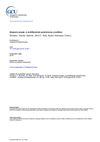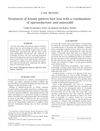TLDR Patients with alopecia areata atopica have lower hair magnesium levels.
The study from 1976 investigated the magnesium content in the hair of patients with alopecia areata atopica, nonatopic dermatological patients, and normal controls using atomic absorption spectroscopy. It found that both groups of patients had lower average magnesium levels compared to normal subjects, although there was significant overlap between the groups. The researchers suggested that the reduced magnesium levels in patients might be attributed to the nonspecific 'metabolic cost' associated with skin diseases.
 January 2023 in “International Journal of Homoeopathic Sciences”
January 2023 in “International Journal of Homoeopathic Sciences” Homoeopathic treatment may help restore hair in Alopecia Areata by balancing the immune system.
 148 citations
,
December 2018 in “Journal of autoimmunity”
148 citations
,
December 2018 in “Journal of autoimmunity” Alopecia areata is an autoimmune disease causing patchy hair loss, often with other autoimmune disorders, but its exact causes are unknown.
May 2018 in “Journal of cosmetology & trichology” Combining platelet-rich plasma therapy with prostaglandin-F eye drops can significantly regrow hair in alopecia universalis.
 21 citations
,
January 2007 in “Australasian Journal of Dermatology”
21 citations
,
January 2007 in “Australasian Journal of Dermatology” Spironolactone and minoxidil together effectively treat female pattern hair loss.
12 citations
,
February 2003 in “PubMed” Androgenetic alopecia can affect adolescents, impacting self-esteem, but minoxidil's effectiveness for them is unclear.


